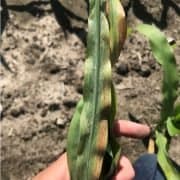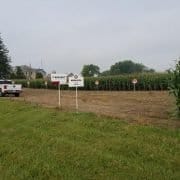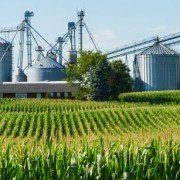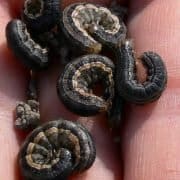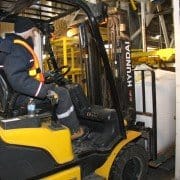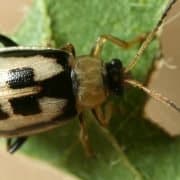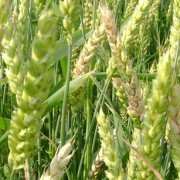Sharing the road – farmers and motorists
/in Grain Marketing, News, Safety/by Ryan MortierNow is the time for field crop harvest, and more motorists will be encountering farm equipment on rural roads, increasing the potential for accidents.
Harvest season generally brings a time when there is an increase in collisions between farm equipment and other vehicles.
Keep in mind the following safety tips for motorists as you share the road with farm equipment:
- Farm machinery has a legal right to use public roads just as other motor vehicles.
- Farm machinery can unexpectedly turn onto a public road from a field or driveway.
- Farm machinery operators may not be able to see you because the large equipment or a load can block part of their rear view.
- Slow-moving farm machinery traveling less than 25 miles per hour should display a slow moving vehicle emblem on the back of the equipment.
- Extra-wide farm machinery may take up more than one lane to avoid hitting obstacles such as mailboxes and road signs.
Before passing farm machinery:
- Look for left turn lights or hand signals. If the machinery slows and pulls toward the right side of the road, the operator is likely preparing to make a wide left turn.
- Be sure there is adequate distance for you to safely pass.
Rural road rage can be negated if everyone takes the responsibility to have extra patience, careful driving habits, and use high-visibility markings and lighting.
Eye injury and prevention
/in Safety, Uncategorized/by Ryan MortierOur eyes are one of our greatest assets. If we don’t protect our eyes from eye injury, we could quickly and easily lose our vision. It’s important to eliminate or engineer out the hazards that could pose hazards to our eyes. Farming can be a very dangerous occupation, so always keep safety in mind.
Most of the hazards to our eyes while working cannot be fully eliminated so proper eye protection is critical. Read more
Mitchell Plot Tour – September 5th and 6th
/in Agronomy, Events, Grain Marketing, News, Uncategorized/by Ryan MortierPreparing silos and bins for harvest
/in Safety/by Ryan MortierBe safe while preparing silos and bins for harvest
We all know that farming is potentially a very dangerous occupation if precautions and safety are not top-of-mind in everything we do. We may, or can easily take for granted every action we perform every day, working at the things we love. Harvest is an exciting time for everyone, but please, take the time to plan every step of the way and come home safe to your loved ones. Read more
Watch for Armyworm in spring cereals and mixed forages
/in Agronomy/by Head OfficeArmyworm has been spotted at low levels in a few winter wheat fields, though being so close to harvest, it is really not a concern in that crop. However, it does indicate a need to keep an eye out for them in spring cereals, as well as mixed forages (as they like to feed on grasses). True armyworm larvae can vary in colour from green to reddish-brown but all have white-bordered stripes running laterally along the body. True armyworm also have dark diagonal bands at the top of each abdominal proleg and a yellowish-brown head with a network of dark-brown lines creating a mottled pattern.

True Armyworm larvae. Photo by T. Baute, OMAFRA.
Scouting Guidelines: Scout every 4 days to stay ahead of any potential invasions. The best time to scout for true armyworm is shortly after dusk when larvae are actively feeding. In cereals and mixed forages, examine 10 areas of the field, assessing the number of larvae per 30 cm x 30 cm (1 ft2). Pay particular attention to the border area directly adjacent to other grassy host crops. During the day, if it is cloudy and overcast, you might be lucky enough to see larvae on the head of the plant but on sunny days, they will be down on the ground among the crop debris or under soil clods. Brown frass may also be present on the plants and on the soil surface. Birds diving into your field is a good indication that there are good eats there so take a look.
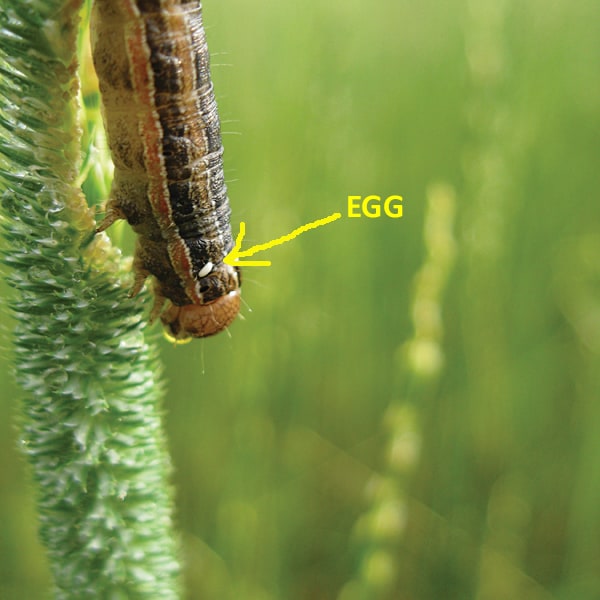
True Armyworm parasitized by Tachinid fly. Photo by J Smith UGRC pointing to egg.
When you do find larvae, look for any white eggs that may be attached to the backs of the armyworm larvae. This is a sign that the larvae have been parasitized by one of its parasites which have done the job for you. Avoid treating with insecticides when large numbers of parasitized larvae are present as they have already been controlled by parasitoids or when larvae are close to 2.5 cm in length, as insecticides will no longer be effective and the larvae will soon stop feeding.
Threshold for Mixed Forages: Control is warranted when five or more larvae (smaller than 2.5 cm) per square foot are found. In seedling crops, two to three larvae (smaller than 2.5 cm) per square foot may warrant control.
Threshold for Cereals: Chemical control is warranted if there are 4 to 5 un-parasitized larvae per 30 cm x 30 cm and the larvae are smaller than 2.5 cm. If a significant amount of wheat head clipping is occurring, spray may be warranted if larvae are still actively feeding, are smaller than 2.5 cm and as long as pre-harvest intervals have not been reached.
Source: Field Crop News
Lifting and rigging safety
/in Agronomy, Safety/by Ryan MortierLifting and rigging work is considered a high hazard task.
Protect yourself, your coworkers and the people around you while performing any hazardous type of work–on the job or at home.
There are a lot of associated hazards that accompany lifting any loads with cranes or equipment. It is important to not only understand proper rigging techniques, but also the other hazards that accompany this type of work task.
Lifting and rigging incidents
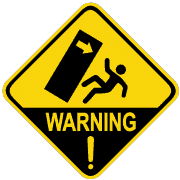 The first type of incident regarding lifting and rigging is some type of breakage of a sling, wire rope, or chain resulting in a dropped load. While these type of incidents usually have the most severe consequences, there are often many other types of less severe incidents that cause the majority of injuries or property damage.
The first type of incident regarding lifting and rigging is some type of breakage of a sling, wire rope, or chain resulting in a dropped load. While these type of incidents usually have the most severe consequences, there are often many other types of less severe incidents that cause the majority of injuries or property damage.
Some of the other injuries and incidents that occur are sprains, falls, crush injuries, electrocutions, and struck-by incidents.
Hazards such as swinging loads, manual handling of heavy rigging, holding on to tag lines, moving equipment, pinch points, working on elevated surfaces, trip hazards, slippery surfaces, etc. can all be present during lifting operations.
Safe work practices
- Anyone in a work area where a lift is being performed should be properly trained on the work scope, hazards, and mitigations of the task.
- Inspect all rigging prior to using it for a lift.
- All rigging should be properly stored after lifting operations are complete. Proper storage helps prevent the rigging from being damaged.
Summary
Proper planning and forethought is important to eliminate hazards and avoid incidents.
Be aware of the hazards that affect you and your coworkers on each unique lift that is completed.
The safety of our employees, customers, contractors, suppliers, visitors and the community is of the utmost importance to us.
Work safe. Farm safe. Home safe.™
Bean Leaf Beetles Showing up in Essex and Chatham Kent
/in Agronomy, News/by Ryan MortierBean leaf beetles (BLB) are showing up in early planted soybeans that were treated with only fungicide seed treatment. As the result of area wide use of insecticide seed treatments, this pest had much of a presence over the last decade. Thankfully, rescue treatments are still possible if threshold has been reached. Read more
Fusarium head blight
/in Agronomy/by Agronomy TeamWhat is it? Fusarium Head Blight is a fungal disease that affects the head of small grain crops. Also referred to as Scab, it can affect wheat, barley, oats, rye, corn, and triticale. Wheat and barley are generally the most affected. It is mainly caused by the species Fusarium graminearum, and can cause loss of […]
To be leaders in the food and agribusiness sector through sustainability, integrity, relationships, employee engagement, profitability and innovation.

